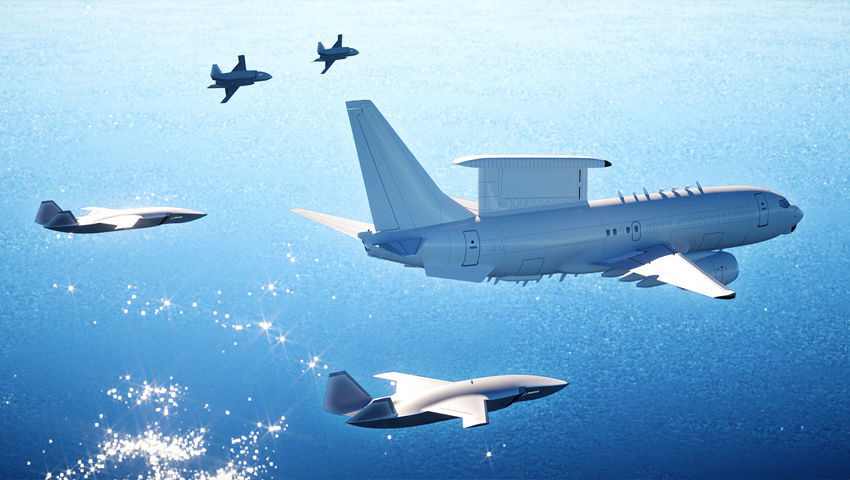The complexity of integrating inter-service platforms is one of the major challenges for AIR 6500 bidders. For Boeing, the success of integrating individual platforms for Army and Air Force has cleared the path forward, promoting partnership between defence primes.
Conceptualised as a "system-of-systems" responsible for combining the data gathering, analysis and firing solutions of inter-service platforms like the F-35 Joint Strike Fighter, E-7A Wedgetail, P-8A Poseidon, Hobart Class and Hunter Class and the National Advanced Surface to Air Missile System (NASAMS) LAND 19 Phase 7B, AIR 6500 has become an increasingly challenging project.
The challenge laid down to industry by the RAAF and government has been taken up enthusiastically by industry keen to be at the cutting-edge of capability delivery, particularly given the opportunity to establish a paradigm-shifting integrated, multi-domain combat and battle management system capable of air and missile defence for a force as technologically advanced as the Australian Defence Force.
Boeing, one of the prime contractors tendering for the AIR 6500 program, has sought to identify the nuances and challenges of the program, while presenting solutions to benefit all parties.
Hugh Webster, chief engineer of new business at Boeing Defence Australia, told Defence Connect, "This complex Joint Integrated Air and Missile Defence (JIAMD) and Battle Management System, really is a necessity for the ADF. The system will 'knit together' individual capability packages SEA 5000 and LAND 19 Phase 7B to existing 'nodes' and 'shooters' like the E-7A Wedgetail and F-35 Joint Strike Fighter."
At present, the challenges are largely defined by integrating a multi-layered system made up of individual platforms, including the short-range, ground based air and missile defence capabilities like Raytheon's NASAMS system as part of LAND 19 Phase 7B, with the ground-based AIR 6500 program and a national Integrated Air and Missile Defence (IAMD) system, which includes platforms like the Hobart and Hunter Class vessels, Wedgetail and F-35.
"From Boeing's perspective, the program is too large and too complex for anyone prime to successfully deliver on its own, particularly without a clearly defined technical roadmap for each of the layers within the proposed 'system-of-systems'," Webster said.
Recognising this, Boeing recognised that success will require a long-term operational and technical roadmap, identifying the need for a single IAMD "glue" that will be responsible for combining the individual and highly specialised capabilities provided by other prime contractors, like Lockheed Martin, Northrop Grumman and Raytheon, through the aforementioned platforms.
"We have looked at each of the contributing platforms, like Lockheed Martin's Aegis in the Hobart and Hunter Class, the F-35, Boeing's Wedgetail, 'Loyal Wingman' and Project Currawong, and the Raytheon NASAMS platform, and recognised we need to focus on working together to deliver the outcome Air Force and government are asking for," Webster explained.
Boeing's technical vision reinforces the need for Defence and industry to work between and among themselves, and with Australian SMEs, to deliver local solutions that can then be paired with the right mix of US technology to deliver best-for-warfighter solutions.
"This technical vision also recognises the unique role Australian SMEs play in the broader equation. World-leading companies like CEA Technologies and Daramont bring unique leading-edge technology, systems and capability solutions to the table," Webster said.
Additionally, Boeing's solution seeks to draw on the methodology of successful integration programs like Project Currawong and the E-7A Wedgetail Airborne Early Warning & Control (AEW&C), particularly the close working relationships between acquirers, operational users and industry. This locally driven success developing and delivering complex "systems-of-systems" programs for the ADF shows that AIR 6500 design, integration, delivery and support would also benefit from a strong Australian presence.
"Our focus isn't on 'shiny new toys', it is on helping Air Force and government to tangibly identify and answer the roadmap questions, while demonstrating the success and precedence Boeing has had combining various prime contractors, platforms, operational users and Australian SMEs to meet clearly defined capability requirements," Webster told Defence Connect.
The AIR 6500 Project presents an opportunity for Australian industry to participate in an exciting and strategically important program to build and maintain an enduring and regionally superior Australian capability, with an opportunity to enter export markets.
The ADF's existing air defence systems will be upgraded or replaced by Project AIR 6500. This investment will provide the foundation for an enhanced, integrated air and missile defence system for the ADF, ensuring that the delivered system is able to fuse and share information to enhance the accuracy and speed of ADF's systems response to air and missile threats.
The delivered architecture will have the flexibility for further enhancement to handle more complex threats and to integrate new technologies as they emerge. The ADF will also acquire ground-based active electronically scanned array radars from around 2020 and expand Australia's access to air and space situational awareness information, including through space-based systems.
A solicitation to industry is expected in 2019. Contract signature for the successful prime systems integrator and system deliverer will be in 2020, with an initial capability to be fielded by 2024.









